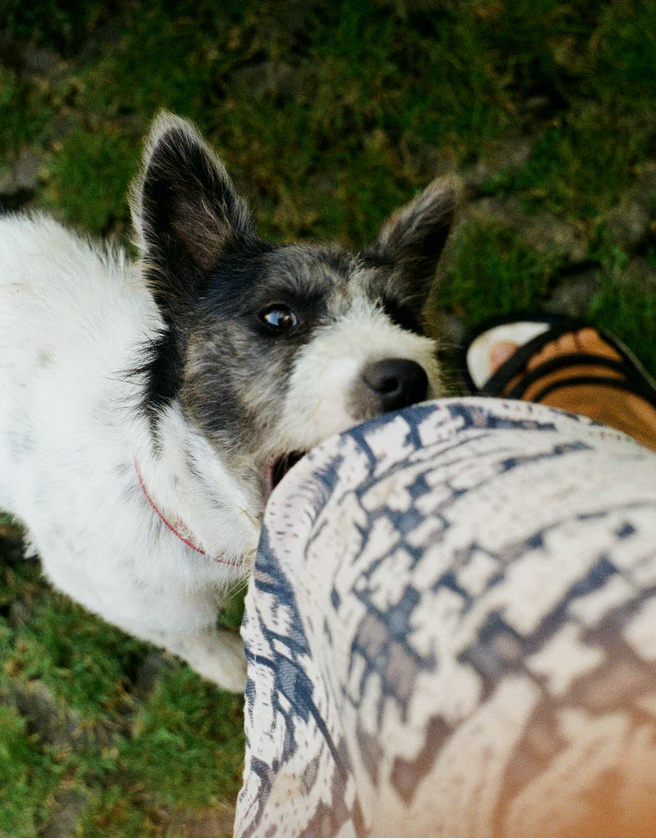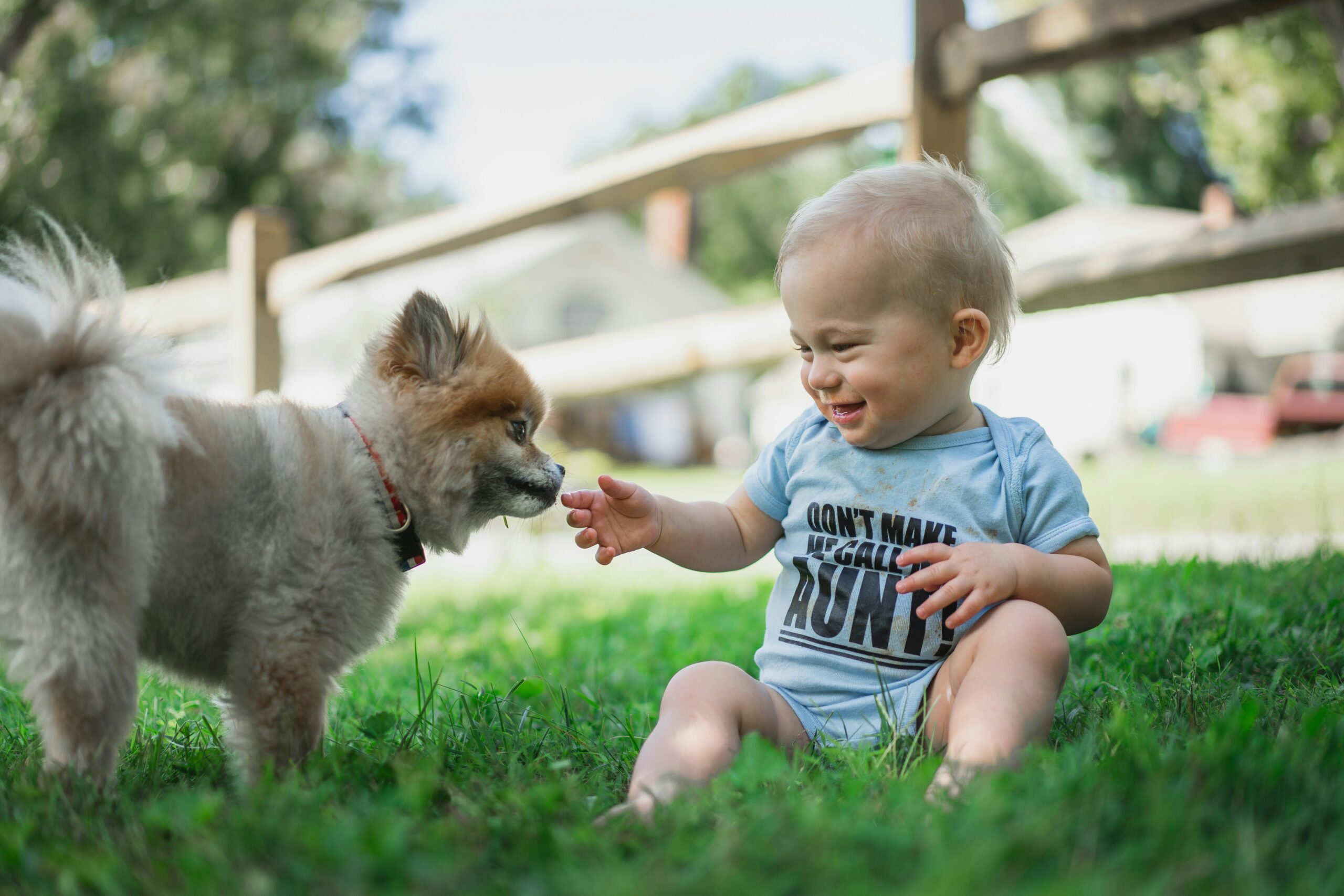There are 4.5 million incidents of dog bites each year in the United States. One out of every five bites is serious enough to warrant medical attention. 30,000 bite victims need reconstructive surgery to repair the damage caused by a dog bite, and 15-20 people die from their bite injury. While many dog bites are minor nips, injuries can go past the skin to affect bones, muscles, nerves and blood vessels. Bites can also become infected with the entry of bacteria into the wound, exposing the victim to the possibility of strep or staph infections.
If the victim has a pre-existing medical condition, the risks of complications are even greater. If the biting dog is not up-to-date on its required rabies vaccine, the bite could transmit rabies, which can be fatal if not treated quickly. It is now recommended that people get a tentanus shot every 5 years.
With such serious potential consequences for a dog bite, dog owners must take responsibility to ensure their pet does not cause injury to others or to themselves. Here are some important tips for dog parents to understand why their dog bites and what they can do to alter the bad behavior.
Reasons Dogs Bite
Aggressive behavior results from specific stimuli, and the aggressive dog usually demonstrates specific postures and telltale signs prior to the bite. Aggressive dog bites are generally quick and more serious than those resulting from playful behavior. The following is a list and description of the typical aggressive triggers for dogs.
Fearful Aggression:
If a dog is afraid of a specific person or animal, he may attack if he believes there is no other option. A dog that is scared will generally strike a fearful posture, such as a crouch or dropping the head and tail, but will attack if they are approached while in this situation. Unlike other types of aggression, the fearful dog may not warn of the upcoming bite with growls or show of teeth; the only warning of the upcoming behavior is the fearful physical posture.
Possessive Aggression:
Although our pets are no longer faced with harsh survival issues that their ancestors faced, dogs may still instinctively guard their possessions from others. For some dogs, this is guarding their food, for others it’s guarding their crate or bed, toys, or bones. If dogs fear that their protected item is being threatened, they may respond with aggressive behavior.
Defensive Aggression:
Dogs behaving in a defensively aggressive manner are motivated by fear, but they don’t try to retreat. Instead, they immediately go on the offense. These dogs demonstrate a mix of fearful postures and offensive postures. A defensively aggressive dog will generally strike first and will back down only when the victim retreats.
Protective Aggression:
Dogs instinctively view their social circle as a pack, whether it’s a group of dogs or a family of humans. Pets may demonstrate aggressive actions if they perceive a family member or friend is endangered.
Territorial Aggression:
Dogs are instinctively territorial, a tendency inherited from ancestral wolves and coyotes. Some pets show these same behaviors, barking and charging at people or animals who come too near their turf. While some people value this guard-dog mentality, it is not good when a dog attacks and bites any “intruder”, friend or foe.
Dominant Aggression:
When a dog feels a challenge to his social status or a lack of control in a social interaction, he may react with aggression. If the dog is well-socialized, he will probably work out issues without other dogs without fighting, but dominance aggression sometimes occurs toward people if the dog is uncertain of the hierarchy. Some dogs believe they are the alpha in their human pack, which can encourage aggressive behavior when they don’t get their way.
Aggression During Play:
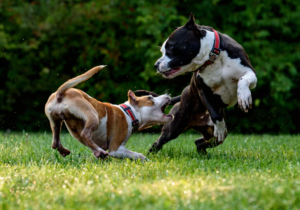
Sometimes aggressive behavior can be unintentionally triggered during play. Frustration-elicited aggression may occur when a dog is excited by something but held back from it. Redirected aggressive behavior happens when a dog is in an aroused state, such as when playing (or, in some cases, attacking), and someone else interferes. The dog’s attention is redirected at the interfering individual, which can result in biting.
Signs of Aggressive Behavior
Dogs typically don’t attack without demonstrating some warning behavior beforehand. An aggressive dog adopts some common physical posturing that should be perceived as a precursor to a bite or attack, including the following:
- Still and rigid body
- Tail tucked between the legs
- Mouth tightly closed
- Bared teeth
- Aggressive eye contact
- Excessive or brisk pacing
- Barking, growling or snarling
- Lunging
Additional Risk Factors
When you have a dog who has demonstrated aggressive behavior, you need to decide whether to take steps for intervention. A dog bite injury attorney can provide additional details and information about this. There are certain factors that make the dog more of a risk to others that should be carefully considered, including the following:
- Size: large dogs are perceived as more threatening with harder bites
- Age: young dogs are believed to be easier to “fix” than older dogs
- Bite history: dogs with a history of biting are an insurance liability
- Severity: dogs whose aggression stops short of biting are easier to deal with
- Predictability: dogs that don’t show consistent warning behavior before delivering a bite allow you to warn others when those signs begin
- Triggers: how often a dog is exposed to the targets or triggers of his aggression is an important factor
Bite Inhibition
Most people think it’s cute when little puppy teeth chew on their fingers and toes, but this behavior is not so fun when those puppy teeth have turned to adult teeth and the dog is much bigger! It’s important to teach dogs not to mouth or bite people.
Make A Loud Yelping Noise
The first step in bite inhibition for young dogs is to demonstrate that human skin is sensitive, and the bite is painful for humans. Dogs may learn this by playing with other dogs, in which chasing, wrestling and biting is a common pastime. When a dog bites his playmate too hard, the victim yelps and play usually ceases temporarily. This teaches the dog to control the bite so there is no injury or interruption to the fun and games.
Dogs can learn the same lessons from their people. When playing with your dog, make a loud noise when he bites too hard and momentarily step away from the play. Praise your dog if he shows remorse by putting his head down or licking you. Resume play and continue this cycle.
Time-Outs
Time-outs can also work if the momentarily stop of play is not effective. Making a loud noise and then ignoring the dog for 10-20 seconds before resuming play should teach your pet that biting stops the playing, but nice behavior allows it to continue.
Redirecting Mouthing Behavior
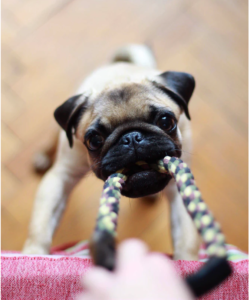
Dogs need to be taught to keep their mouths away from people. Use these tips:
- Offer your dog a chew toy when he tries to gnaw on your fingers
- If your dog gets excitable and mouthy when you pet him, distract him by feeding small treats from your other hand.
- To discourage a dog from biting feet, stop moving your feet when the dog pounces on them and start waving a toy around. When the dog grabs the toy, you can move again. Continue this cycle with praise and redirection until the dog learns to stop attacking your feet.
- Teach impulse-control skills such as sit, wait, and leave it. By learning to respond to these commands, dogs can be redirected from biting.
Encouraging Gentle Play
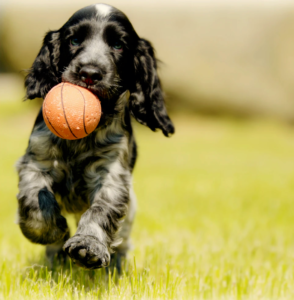
Instead of wrestling or playing rough with your hands, encourage your dog to engage in non-contact play such as tug-of-war or fetch with a ball or frisbee. Tug-of-war is a great way to prepare your dog for dealing with frustration. Keep tug toys easily accessible so you can redirect your dog to the tug toy if he starts to put his mouth on you. This should teach your dog to look for a toy if he feels the urge to bite.
Using Deterrents
Bad-tasting sprays are available as a training tool. Spray the deterrent on areas that your dog tends to bite before you interact with him. If he puts his mouth on you, stop moving and wait for the deterrent to take effect. Praise him when he lets go. Using the taste deterrent for two weeks should be enough time for the dog to learn to stop biting.
A similar method can be used with a can of peppermint or spearmint breath spray. As soon as the dog begins to bite, make a loud noise like “ouch” and squirt a small burst of breath spray in his mouth. The taste and sensation are unpleasant, so this should only take a few times before your dog gets the point. If this deterrent can’t be accomplished quickly and smoothly, abandon the effort; you don’t want the dog to become fearful of you or to encourage aggressive behavior.
Always remember that physical punishment can make your dog fearful of you and encourage additional aggression. Positive reinforcement is always the best way to avoid bad behavior, along with making sure your pet feels safe and secure. Any time you are concerned about your dog’s aggressive actions, you should involve your veterinarian and seek professional assistance.
Photo credit:
https://unsplash.com/photos/PE69hOLm8H4
https://unsplash.com/photos/5gXPapBz40c
https://unsplash.com/photos/RUgbGfdma6U
https://unsplash.com/photos/ff221Bu56mI
Love our content? Share it with a friend or link it to social media. Like short clips of cute household pets? Training tips? Follow us on instagram @nydognanny or on YouTube at nydognanny. Have some news you needs to get to dog and cat parents stat? Email info@newyorkdognanny.com with your article pitch.

